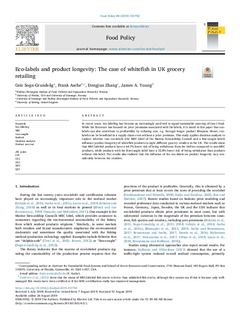| dc.contributor.author | Sogn-Grundvåg, Geir | |
| dc.contributor.author | Asche, Frank | |
| dc.contributor.author | Zhang, Dengjun | |
| dc.contributor.author | Young, James A. | |
| dc.date.accessioned | 2019-10-29T14:10:36Z | |
| dc.date.available | 2019-10-29T14:10:36Z | |
| dc.date.created | 2019-09-25T09:27:20Z | |
| dc.date.issued | 2019-08 | |
| dc.identifier.citation | Sogn-Grundvåg, G., Asche, F., Zhang, D., Young, J. (2019) Eco-labels and product longevity: The case of whitefish in UK grocery retailing. Food Policy, 88 . | nb_NO |
| dc.identifier.issn | 0306-9192 | |
| dc.identifier.uri | http://hdl.handle.net/11250/2625197 | |
| dc.description.abstract | In recent years, eco-labeling has become an increasingly used tool to signal sustainable sourcing of (sea-) food. While the literature has focused on price premiums associated with the labels, it is noted in this paper that ecolabels can also contribute to profitability by reducing cost, e.g. through longer product lifespans. Hence, ecolabels can be beneficial in a supply chain even without a price premium. This study applies duration analysis to explore whether two eco-labels (the MSC label of the Marine Stewardship Council and a line-caught label) influence product longevity of whitefish products in eight different grocery retailers in the UK. The results show that MSC labeled products have a 64.7% lower risk of being withdrawn from the shelves compared to non-MSC products, while products with the line-caught label have a 32.8% lower risk of being withdrawn than products without this label. The results also indicate that the influence of the eco-labels on product longevity vary considerably between the retailers. | nb_NO |
| dc.language.iso | eng | nb_NO |
| dc.publisher | Elsevier Ltd. | nb_NO |
| dc.rights | Navngivelse-Ikkekommersiell 4.0 Internasjonal | * |
| dc.rights.uri | http://creativecommons.org/licenses/by-nc/4.0/deed.no | * |
| dc.subject | sjømat | nb_NO |
| dc.subject | økonomi | nb_NO |
| dc.subject | produkters levetid | nb_NO |
| dc.title | Eco-labels and product longevity: The case of whitefish in UK grocery retailing | nb_NO |
| dc.type | Journal article | nb_NO |
| dc.type | Peer reviewed | nb_NO |
| dc.description.version | publishedVersion | nb_NO |
| dc.rights.holder | © 2019 The Authors. | nb_NO |
| dc.subject.nsi | VDP::Social science: 200::Economics: 210::Business: 213 | nb_NO |
| dc.source.pagenumber | 10 | nb_NO |
| dc.source.volume | 88 | nb_NO |
| dc.source.journal | Food Policy | nb_NO |
| dc.identifier.doi | 10.1016/j.foodpol.2019.101750 | |
| dc.identifier.cristin | 1728654 | |
| dc.relation.project | Fiskeri- og havbruksnæringens forskningsfinansiering: 900276 | nb_NO |
| dc.relation.project | Nofima AS: 12245 | nb_NO |
| dc.relation.project | Nofima AS: 10920 | nb_NO |
| dc.relation.project | Norges forskningsråd: 281040 | nb_NO |
| dc.relation.project | Andre: 1015617 | nb_NO |
| dc.relation.project | Norges forskningsråd: 233751 | nb_NO |
| cristin.unitcode | 217,8,3,0 | |
| cristin.unitcode | 217,14,2,0 | |
| cristin.unitname | Institutt for sikkerhet, økonomi og planlegging | |
| cristin.unitname | Avdeling for regnskap og rettsvitenskap | |
| cristin.ispublished | true | |
| cristin.fulltext | postprint | |
| cristin.fulltext | original | |
| cristin.qualitycode | 1 | |

